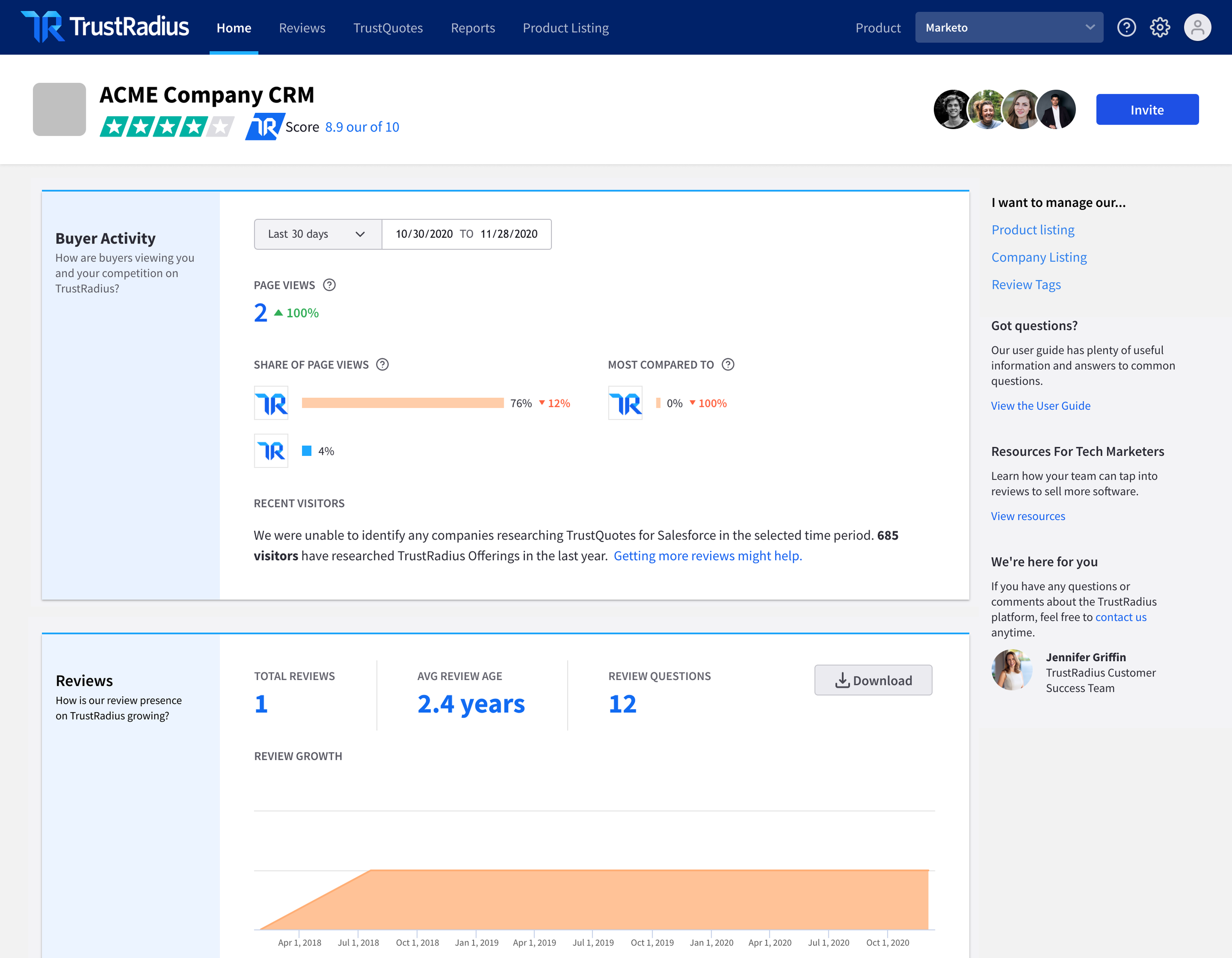Building demand &
delivering customer insights for software vendors
TrustRadius is a buyer intelligence platform that partners with software companies to drive user reviews, generate intent signals on in-market buyers looking for the best fit for their software needs, and understand their business and position in the market vs their competitors. As the market has continued to grow, so has the need for a service to help buyers and vendors connect meaningfully.
We looked to understand how best to align with vendor needs and mental models, rebuild our technology, and commit to an iterative approach to deliver value to users at each step of the way.
What we achieved in the vendor experience
2.8x
Increase in monthly active users
13%
Increase in daily active users
8%
Increase in days active (avg 2.54)
2.7x
Increase in features adoption
The goal
Create a frictionless experience that delivers real value and information to vendors, improving customer retention and creating more growth opportunities because vendors will be able to see and assess the value of working with TrustRadius.
The challenge
The TrustRadius vendor portal experience isn’t meeting the needs of our users and has an outdated build making it difficult to work on improvements.
Areas of opportunity
-
With a confusing information architecture and missing features, users had a hard time talking about the value of TrustRadius unless they worked with an account or support person.
-
After years of additive work to the TrustRadius product to meet the growing needs of users, it struggled to keep up and became a fragmented experience for vendors. This meant that users struggled to complete basic tasks and so much of our product experience relied on our internal support teams.
-
The current experience was missing a focus on self service. So much of the experience required reaching out to a person to understand how your product(s) was performing with buyers and against your competitors.
-
Enterprise customers weren’t using the vendor portal other than to edit the product listings because the reporting they need goes far beyond what the product was capable of.
-
Built on a outdated tech stack, any work done to the vendor experience was time intensive and struggled to be performant. We knew this was something we would have to tackle if we were going to scale and remain a competitive offering for customers.
Learning from our users
Overall, TrustRadius serves as a valuable platform for vendors across various departments to gather insights, improve their products, and enhance their market positioning.
We interviewed internal and external vendor portal user. We wanted to learn what our team was hearing in their daily conversations with users and what are our customers saying about the experience.
-
Monitor their product's reputation, gather user-generated content for marketing campaigns, and understand how their product compares to competitors in the market.
-
Access customer reviews and ratings to support their sales pitches, showcase social proof to potential customers, and gain insights into customer pain points and needs.
-
Monitor customer feedback, identify trends in customer satisfaction or dissatisfaction, and address any issues or concerns raised by users.
-
Gather feedback on their products, understand user needs, and identify areas for improvement.
-
Gain insights into market perception of their products, monitor their product's performance and competitiveness, and inform strategic decision-making.
Defining a new product structure
After auditing our product experience we began mapping out a new experience that better aligned with users needs and showcased a clear pathway to proving ROI. This meant detailing out new and updated areas as well as what feature sets we should retire.
Balancing the new vs legacy product experience
With the new experienced outlines, we focused on how we would iteratively provide value to customers while making updated to the experience and the tech. With this approach, we could avoid trying to rebuild the entire experience for years in the background. By partnering with internal stakeholders and leveraging our user feedback, we defined the stepped approach to our vision for the vendor experience.
Connecting the two vendor portals
Our approach had to deliver continuous value as we rolled out updates. Which meant slowly sunsetting parts of the product experience in the legacy portal while we replace then in the new experience. By rebuilding the navigation with the new information architecture we were able to accomplish this much easier.
Creating an onboarding path & user self service
As we learned from our initial audit, we needed to create a space for our internal teams to communicate different types if updates to users as well as callouts for customers to progressively onboarded to features to showcase the value of TrustRadius for vendors.
Designed for continued learnings
After we defined the new structure of the updated portal, we created the dashboard as the first new space to introduce the improved experience.
For this feature we leveraged the side rail areas to trial small versions of future larger concepts. This gave us a lightweight way to gauge user interest along side our usability testing.
User feedback
Being a small organization and wanting to move quickly with as much constant user input, we created user study templates to share with our internal customer account representatives.
Usability study results for new dashboard: 82% success
4 In-person studies
13 remote studies
With a few friction points to action on, we continued to make updates to this section of the new experience while starting work on the next set of planned work.
A pattern for fast and validated product launches
Our team’s efforts to define our roadmap into manageable chapters allowed our design effort to stay ahead of the development process while also allotting time for constant user input.
Discovery -> Design -> User Research -> Improvements -> Development
For more information on this project, reach out via howdymagen@gmail.com










